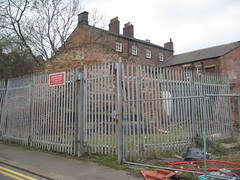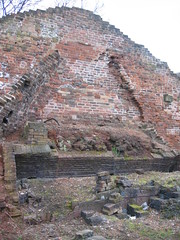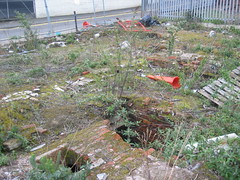 I thought I'd show you another stop on the Kelham Furnace Trail. At Bower Spring (do not be misled by the idyllic-sounding name) are the remains of two cementation furnaces.
I thought I'd show you another stop on the Kelham Furnace Trail. At Bower Spring (do not be misled by the idyllic-sounding name) are the remains of two cementation furnaces.Unlike the nearby Doncaster Street furnace, these are ruined, so you can see inside. Unfortunately that is not the only difference between the two sites: these furnaces are on a site that does not appear to be particularly well cared for, neither are they very welcoming for visitors at the moment.
Bower Spring is adjacent to the new section of the Inner Relief Road. The road avoided the furnaces, but the site is littered with junk that has apparently been left behind by the road's builders: traffic cones, roadworks signs, buckets, discarded clothing and other assorted litter are all strewn around the site.
 The furnaces are a scheduled monument, so they are are fenced off - and quite right too. The furnace structure needs protection and the unwary visitor could easily cause damage to themselves or to the remains on the site. Unfortunately the manner in which the area is currently fenced off is awful - it is a mixture of security fencing and partially collapsed temporary fencing of the type that normally surrounds building sites. In short it is both ugly and ineffective, plus it obscures the ruined furnaces. I hope that this situation is just a temporary hangover from the construction of the new road.
The furnaces are a scheduled monument, so they are are fenced off - and quite right too. The furnace structure needs protection and the unwary visitor could easily cause damage to themselves or to the remains on the site. Unfortunately the manner in which the area is currently fenced off is awful - it is a mixture of security fencing and partially collapsed temporary fencing of the type that normally surrounds building sites. In short it is both ugly and ineffective, plus it obscures the ruined furnaces. I hope that this situation is just a temporary hangover from the construction of the new road.The only concession to visitors seems to be a sign, mounted high on the security fence:
"Bower Spring Furnaces
These remains of 19th cent[ury] furnaces for making cementation steel are a scheduled monument.
They belong to the South Yorkshire Industrial History Society.
Contact point: Kelham Island Industrial Museum."
These remains of 19th cent[ury] furnaces for making cementation steel are a scheduled monument.
They belong to the South Yorkshire Industrial History Society.
Contact point: Kelham Island Industrial Museum."
It seems that it is not just the Furnace Trail web link that is not yet ready for visitors, this part of the actual trail is currently somewhat less than welcoming.
 However, despite the sorry state of the site, it is still most definitely worth stopping to look. Where else could you can see exactly what a cementation furnace was like inside?
However, despite the sorry state of the site, it is still most definitely worth stopping to look. Where else could you can see exactly what a cementation furnace was like inside?These furnaces were obviously much smaller than the one on the Doncaster Street site, I found it hard to imagine how cramped the working conditions must have been. One furnace has been reduced to little more than a tell-tale outline on the wall at the back of the site, but the other is still partially intact.
One of the stone coffins is still in place, this is a large chest that held the iron bars and charcoal which were converted to blister steel during the cementation process. Next to the coffin are brick built structures which were part of the flue system. A small section of the furnace wall is still standing, as is part of the vaulted section over the coffin - the surface of which is heavily glazed from the heat experienced during firing. Away from the furnace itself, some brickwork hints at the existence of the cellar, where the coal was fired to heat the furnace. The holes in the picture below almost certainly belonged to a completely different type of furnace: crucible furnaces were often found along cementation furnaces, including at this site. The whole structure resembles a kind of 3D cut away model.
 The Doncaster Street furnace is impressive, but left me wanting to see inside, here it is possible to do exactly that.
The Doncaster Street furnace is impressive, but left me wanting to see inside, here it is possible to do exactly that.Links
This furnace is part of the Kelham Furnace Trail. A leaflet describing the trail is available from local bookshops, including the one at Abbeydale Industrial Hamlet. The leaflet gives a link to Upper Don Walk trust's site but there don't seem to be details of The Furnace Trail online just yet.
All my posts about the Kelham Furnace Trail
My Flickr photoset for this furnace
The Winter 2005/06 edition of the Historical Metallurgy Society's newsletter includes an article about Bower Springs and the archaeological research carried out here before the road was built. [pdf document]
Events listings for the South Yorkshire Industrial History Society
--
Originally published here on my main blog http://three-legged-cat.blogspot.com/
Comments on the original post
